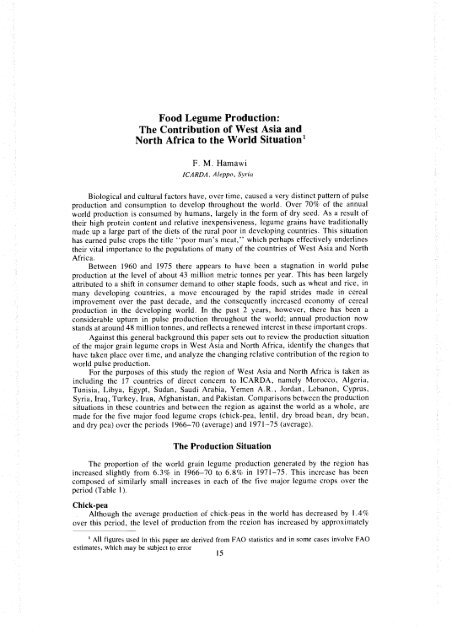I ARCHIV - International Development Research Centre
I ARCHIV - International Development Research Centre
I ARCHIV - International Development Research Centre
- No tags were found...
Create successful ePaper yourself
Turn your PDF publications into a flip-book with our unique Google optimized e-Paper software.
Food Legume Production:<br />
The Contribution of West Asia and<br />
North Africa to the World Situation'<br />
F. M. Hamawi<br />
ICARDA, Aleppo, Syria<br />
Biological and cultural factors have, over time, caused a very distinct pattern of pulse<br />
production and consumption to develop throughout the world. Over 70% of the annual<br />
world production is consumed by humans, largely in the form of dry seed. As a result of<br />
their high protein content and relative inexpensiveness, legume grains have traditionally<br />
made up a large part of the diets of the rural poor in developing countries. This situation<br />
has earned pulse crops the title "poor man's meat," which perhaps effectively underlines<br />
their vital importance to the populations of many of the countries of West Asia and North<br />
Africa.<br />
Between 1960 and 1975 there appears to have been a stagnation in world pulse<br />
production at the level of about 43 million metric tonnes per year. This has been largely<br />
attributed to a shift in consumer demand to other staple foods, such as wheat and rice, in<br />
many developing countries, a move encouraged by the rapid strides made in cereal<br />
improvement over the past decade, and the consequently increased economy of cereal<br />
production in the developing world. In the past 2 years, however, there has been a<br />
considerable upturn in pulse production throughout the world; annual production now<br />
stands at around 48 million tonnes, and reflects a renewed interest in these important crops.<br />
Against this general background this paper sets out to review the production situation<br />
of the major grain legume crops in West Asia and North Africa, identify the changes that<br />
have taken place over time, and analyze the changing relative contribution of the region to<br />
world pulse production.<br />
For the purposes of this study the region of West Asia and North Africa is taken as<br />
including the 17 countries of direct concern to ICARDA, namely Morocco, Algeria,<br />
Tunisia, Libya, Egypt, Sudan, Saudi Arabia, Yemen A.R., Jordan, Lebanon, Cyprus,<br />
Syria, Iraq, Turkey, lrai, Afghanistan, and Pakistan. Comparisons between the production<br />
situations in these countries and between the region as against the world as a whole, are<br />
made for the five major food legume crops (chick-pea, lentil, dry broad bean, dry bean,<br />
and dry pea) over the periods 1966-70 (average) and 197 1-75 (average).<br />
The Production Situation<br />
The proportion of the world grain legume production generated by the region has<br />
increased slightly from 6.3% in 1966-70 to 6.8% in 1971-75. This increase has been<br />
composed of similarly small increases in each of the five major legume crops over the<br />
period (Table 1).<br />
Chick-pea<br />
Although the average production of chick-peas in the world has decreased by 1 .4%<br />
over this period, the level of production from the region has increased by approximately<br />
1 All figures used in this paper are derived from FAO statistics and in some cases involve FAO<br />
estimates, which may be subject to error

















